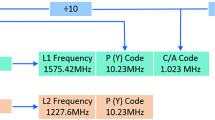Abstract
The massive number of global navigation satellite system (GNSS) users and frequent positioning demands in cities, as well as the complexity of urban scenarios, pose many challenges for the accuracy and reliability of precise positioning. Since urban environments tend to suffer from GNSS non-line-of-sight (NLOS) signal conditions, leading to large ranging errors, NLOS signal identification and processing are of great importance. Usually, a visual camera can reflect real occlusion, and machine learning is efficient and accurate in processing multiple types of features. Therefore, an algorithm is proposed that combines the advantages of both methods. First, NLOS labels are generated using a combination of an inertial navigation system (INS) and a fisheye camera, and a total of nine features, namely, the elevation angle as well as the signal-to-noise ratios (SNRs), SNR fluctuation magnitudes, pseudorange consistencies, and pseudorange multipath errors at two frequencies, are extracted. Then, to improve efficiency and avoid overfitting, the nine original features are aggregated into three common factors via factor analysis, and these three factors can be well interpreted. Finally, a NLOS signal identification model based on the random forest (RF) algorithm is designed. In addition, to improve the precise point positioning (PPP) performance, a weighting scheme based on the elevation angle and SNR is optimized in accordance with the probability of NLOS occurrence. In an experiment, the RF model is trained using on-board dynamic multi-GNSS dual-frequency data collected by a low-cost UBLOX F9P receiver in Wuhan, and then validation is performed using data collected in Wuhan and Zhengzhou. The experimental results show that compared with the gradient boosted decision tree (GBDT), support vector machine (SVM), naive Bayes (NB), and convolutional neural network (CNN) algorithms, the RF model shows superior performance. While achieving 87.5% and 72.5% accuracy on the local and remote test datasets, respectively, the RF model costs only 12.2 ms for LOS/NLOS classification per epoch. Moreover, through factor analysis, the computational efficiency is improved by 29.5% for all five algorithms. Additionally, the accuracy and stability of uncombined PPP are improved using the proposed weighting strategy.

















Similar content being viewed by others
Data availability
The data analysed during the current study are available from the corresponding author upon reasonable request.
References
Adjrad M, Groves PD (2017) Enhancing least squares GNSS positioning with 3D mapping without accurate prior knowledge. Navig J Inst Navig 64(1):75–91. https://doi.org/10.1002/navi.178
Breiman L (2001) Random forests. Mach Learn 45:5–32. https://doi.org/10.1023/A:1010933404324
De la Fuente-Fernández S (2011) Factorial analysis. Dissertation, University Autónoma Madrid
Groves PD (2011) Shadow matching: a new GNSS positioning technique for urban canyons. J Navig 64(3):417–430. https://doi.org/10.1017/S0373463311000087
Hein GW (2020) Status, perspectives and trends of satellite navigation. Satell Navig 1:22. https://doi.org/10.1186/s43020-020-00023-x
Hsu LT (2018) Analysis and modeling GPS NLOS effect in highly urbanized area. GPS Solut 22(1):7. https://doi.org/10.1007/s10291-017-0667-9
Hsu LT, Tokura H, Kubo N, Gu Y, Kamijo S (2017) Multiple faulty GNSS measurement exclusion based on consistency check in urban canyons. IEEE Sens J 17(6):1909–1917. https://doi.org/10.1109/JSEN.2017.2654359
Hsu LT (2017b) GNSS multipath detection using a machine learning approach. In: 2017 IEEE 20th international conference on intelligent transportation systems (ITSC). IEEE, Yokohama, Japan, pp 1–6. https://doi.org/10.1109/ITSC.2017.8317700
Jiang Z, Groves P (2014) NLOS GPS signal detection using a dual-polarisation antenna. GPS Solut 18(1):15–26. https://doi.org/10.1007/s10291-012-0305-5
Jiang C, Xu B, Hsu LT (2021) Probabilistic approach to detect and correct GNSS NLOS signals using an augmented state vector in the extended Kalman filter. GPS Solut 25(2):72. https://doi.org/10.1007/s10291-021-01101-6
Kumar R, Petovello M (2017) 3D building model-assisted snapshot positioning algorithm. GPS Solut 21(4):1923–1935. https://doi.org/10.1007/s10291-017-0661-2
Leech N, Barrett K, Morgan GA (2013) SPSS for intermediate statistics: use and interpretation. Routledge, New York. https://doi.org/10.4324/9781410616739
Li X, Huang J, Li X, Shen Z, Han J, Li L, Wang B (2022) Review of PPP-RTK: achievements, challenges, and opportunities. Satell Navig 3:28. https://doi.org/10.1186/s43020-022-00089-9
Li L, Elhajj M, Feng Y, Ochieng WY (2023) Machine learning based GNSS signal classification and weighting scheme design in the built environment: a comparative experiment. Satell Navig 4:12. https://doi.org/10.1186/s43020-023-00101-w
Li X, Xu Q, Li X, Xin H, Yuan Y, Shen Z, Zhou Y (2024) Improving PPP-RTK-based vehicle navigation in urban environments via multilayer perceptron-based NLOS signal detection. GPS Solut 28:29. https://doi.org/10.1007/s10291-023-01567-6
Liu Q, Huang Z, Wang J (2019) Indoor non-line-of-sight and multipath detection using deep learning approach. GPS Solut 23(3):75. https://doi.org/10.1007/s10291-019-0869-4
Liu Q, Gao C, Shang R, Peng Z, Zhang R, Gan L, Gao W (2023) NLOS signal detection and correction for smartphone using convolutional neural network and variational mode decomposition in urban environment. GPS Solut 27(1):31. https://doi.org/10.1007/s10291-022-01369-2
Lyu Z, Gao Y (2020) A new method for non-line-of-sight GNSS signal detection for positioning accuracy improvement in urban environments. In: ION GNSS 2020, Institute of Navigation, Virtual, pp 2972–2988. https://doi.org/10.33012/2020.17662
Marais J, Meurie C, Attia D, Ruichek Y, Flancquart A (2014) Toward accurate localization in guided transport: combining GNSS data and imaging information. Transp Res Part C Emerg Technol 43(2):188–197. https://doi.org/10.1016/j.trc.2013.11.008
Meguro J, Murata T, Takiguchi J, Amano Y (2009) GPS multipath mitigation for urban area using omnidirectional infrared camera. IEEE Trans Intell Transp Syst 10(1):22–30. https://doi.org/10.1109/TITS.2008.2011688
Nitin K (2006) Dimensionality reduction using factor analysis. Dissertation, Griffith university
Siemuri A, Kuusniemi H, Elmusrati MS, Valisuo P, Shamsuzzoha A (2021) Machine learning utilization in GNSS-use cases, challenges and future applications. In: 2021 International conference on localization and GNSS (ICL-GNSS), Tampere, Finland, IEEE, pp 1–6. https://doi.org/10.1109/ICL-GNSS51451.20219452295
Sun Y, Wang J (2022) Mitigation of multipath and NLOS with stochastic modeling for ground-based indoor positioning. GPS Solut 26(2):47. https://doi.org/10.1007/s10291-022-01230-6
Sun R, Wang G, Zhang W, Hsu LT, Ochieng WY (2020) A gradient boosting decision tree based GPS signal reception classification algorithm. Appl Soft Comput 86:105942. https://doi.org/10.1016/j.asoc.2019.105942
Sunirana J, Zornoza JM, Hernández-Pajares M (2013) GNSS data processing. In volume I: fundamentals and algorithms, ESA Communications, Paris, pp 98
Suzuki T, Matsuo K, Amano Y (2020) Rotating GNSS antennas: simultaneous LOS and NLOS multipath mitigation. GPS Solut 24(3):86. https://doi.org/10.1007/s10291-020-01006-w
Tay S, Marais J (2013) Weighting models for GPS Pseudorange observations for land transportation in urban canyons. In: 6th European workshop on GNSS signals and signal processing, Munich, Germany
Won JH, Pany T (2017) Signals processing. In: Teunissen PJG, Montenbruck O (eds) Springer handbook of global navigation satellite systems. Springer, New York, pp 401–442. https://doi.org/10.1007/978-3-319-42928-1
Xin S, Geng J, Zhang G, Ng HF, Guo J, Hsu LT (2022) 3D-mapping-aided PPP-RTK aiming at deep urban canyons. J Geod 96(10):78. https://doi.org/10.1007/s00190-022-01666-1
Yozevitch R, Ben MB, Weissman A (2016) A robust GNSS LOS/NLOS signal classifier. Navig J Inst Navig 63(4):429–442. https://doi.org/10.1002/navi.166
Zhang G, Wen W, Hsu LT (2019) Rectification of GNSS-based collaborative positioning using 3D building models in urban areas. GPS Solut 23(3):83. https://doi.org/10.1007/s10291-019-0872-9
Zhang Z, Li Y, He X, Chen W, Li B (2022) A composite stochastic model considering the terrain topography for real-time GNSS monitoring in canyon environments. J Geod 96(10):79. https://doi.org/10.1007/s00190-022-01660-7
Zhu B, Yang C, Liu Y (2021) Analysis and comparison of three unsupervised learning clustering methods for GNSS multipath signals. Acta Geod et Cartogr Sin 50(12):1762–1771. https://doi.org/10.11947/j.AGCS.2021.20210233
Acknowledgements
The authors thank the GREAT team led by Prof. Xingxing Li for offering the observation data from Wuhan and CODE for providing precise satellite products.
Funding
This study was supported by the National Natural Science Foundation of China (No. 42104033), the Postdoctoral Science Foundation of China (Grant Nos. 2022M712442), and the State Key Laboratory of Geo-information Engineering (SKLGIE2023-Z-2-1).
Author information
Authors and Affiliations
Contributions
LYL and ZBX provided the initial idea and wrote the manuscript; ZJ and LGL helped with performing the experiments, and YS helped with analysing the data. All authors assisted with the writing, providing helpful suggestions and reviewing the manuscript.
Corresponding author
Ethics declarations
Conflict of interest
The authors declare no conflicts of interest.
Ethical approval
Not applicable.
Consent to participate
Not applicable.
Consent for publication
The authors confirms that the work described has not been published before; that it is not under consideration for publication elsewhere; that its publication has been approved by all coauthors, if any; and that its publication has been approved by the responsible authorities at the institution where the work was carried out.
Additional information
Publisher's Note
Springer Nature remains neutral with regard to jurisdictional claims in published maps and institutional affiliations.
Rights and permissions
Springer Nature or its licensor (e.g. a society or other partner) holds exclusive rights to this article under a publishing agreement with the author(s) or other rightsholder(s); author self-archiving of the accepted manuscript version of this article is solely governed by the terms of such publishing agreement and applicable law.
About this article
Cite this article
Li, L., Xu, Z., Jia, Z. et al. An efficient GNSS NLOS signal identification and processing method using random forest and factor analysis with visual labels. GPS Solut 28, 77 (2024). https://doi.org/10.1007/s10291-024-01624-8
Received:
Accepted:
Published:
DOI: https://doi.org/10.1007/s10291-024-01624-8




